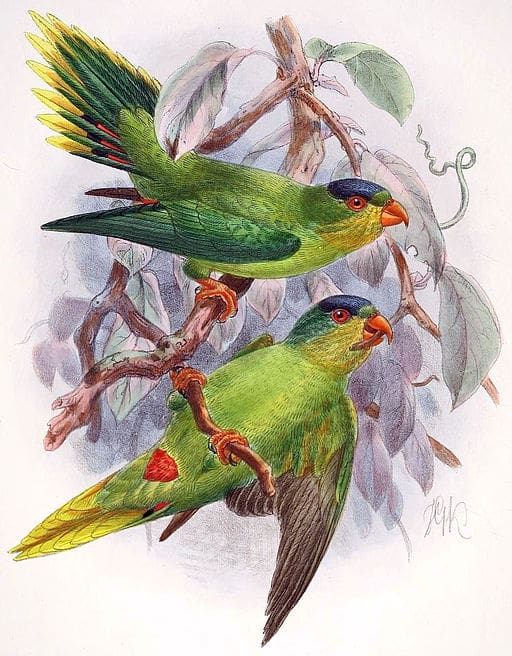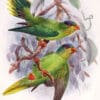New Caledonian Lorikeet
Also known as:
Diademed Lorikeet, New Caledonian Diademed Lorikeet
Also known as:
Diademed Lorikeet, New Caledonian Diademed Lorikeet

Charmosyna

diadema
Size:
19 cm (7.4 in)
Weight:
Not recorded.
Subspecies including nominate:
one
Colour Adult:
Male-undescribed. Female-in general green; yellow cheeks and throat; purple/blue crown; olive/brown wash on mantle; purple/blue wash on thighs; red vent; green tail, with red at lateral feather bases. Beak orange/red.
Colour Juvenile:
Not recorded.
Call:
Not recorded.
More Information:
Content Sources:
CITES
Avibase
BirdLife International
Cornell Lab of Ornithology/Birds of the World
A Guide to Parrots of the World, Juniper and Parr, 1998
Parrots of the World, Forshaw, 2006. 2010 edition
Vanished and Vanishing Parrots, Forshaw, 2017.
Captive Status:
Not found in captivity.
Longevity:
—
Housing:
—
Diet:
—
Enrichment:
—
Nest Box Size:
—
Clutch Size:
Not recorded.
Fledging Age:
—
Hatch Weight:
—
Peak Weight:
—
Weaning Weight:
—
World Population:
< 50, with no sightings since 1976. Population trend is unknown.
IUCN Red List Status:
Critically Endangered
CITES Listing:
Appendix II
Possibly extinct.
Threat Summary:
A BirdLife ‘restricted-range’ species. Possibly has requirements for lowland semi-deciduous forests, which have almost disappeared from the island. Also, introduced diseases (avian malaria) or predators may have caused it to decline.
Range:
Recorded from Viti Levu, Vanua Levu, Ovalau and Taveuni, Fiji Islands.
Habitat:
Forest edge of rainforest near to Melaleuca woodland.
Wild Diet:
Presumably pollen and nectar.
Ecology and Behaviour:
Reports early on indicated that this lorikeet lived in forest and sometimes fed in Erythina trees (Layard and Layard 1882). It is thought that it and closely-related Charmosyna range into lowland forests from mountain forest, depending on the season (Forshaw 1989).
Clutch and Egg Size:
Not recorded.
Breeding Season:
Possibly July-December

